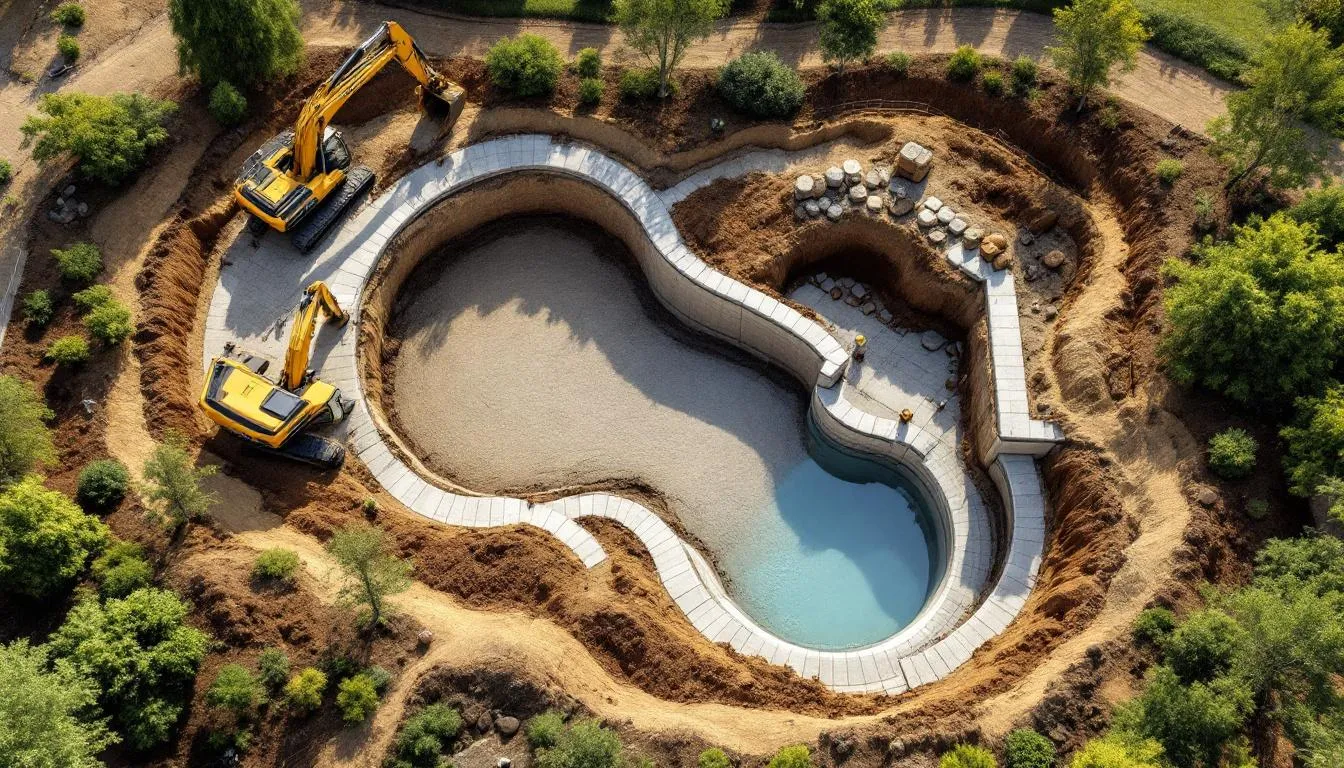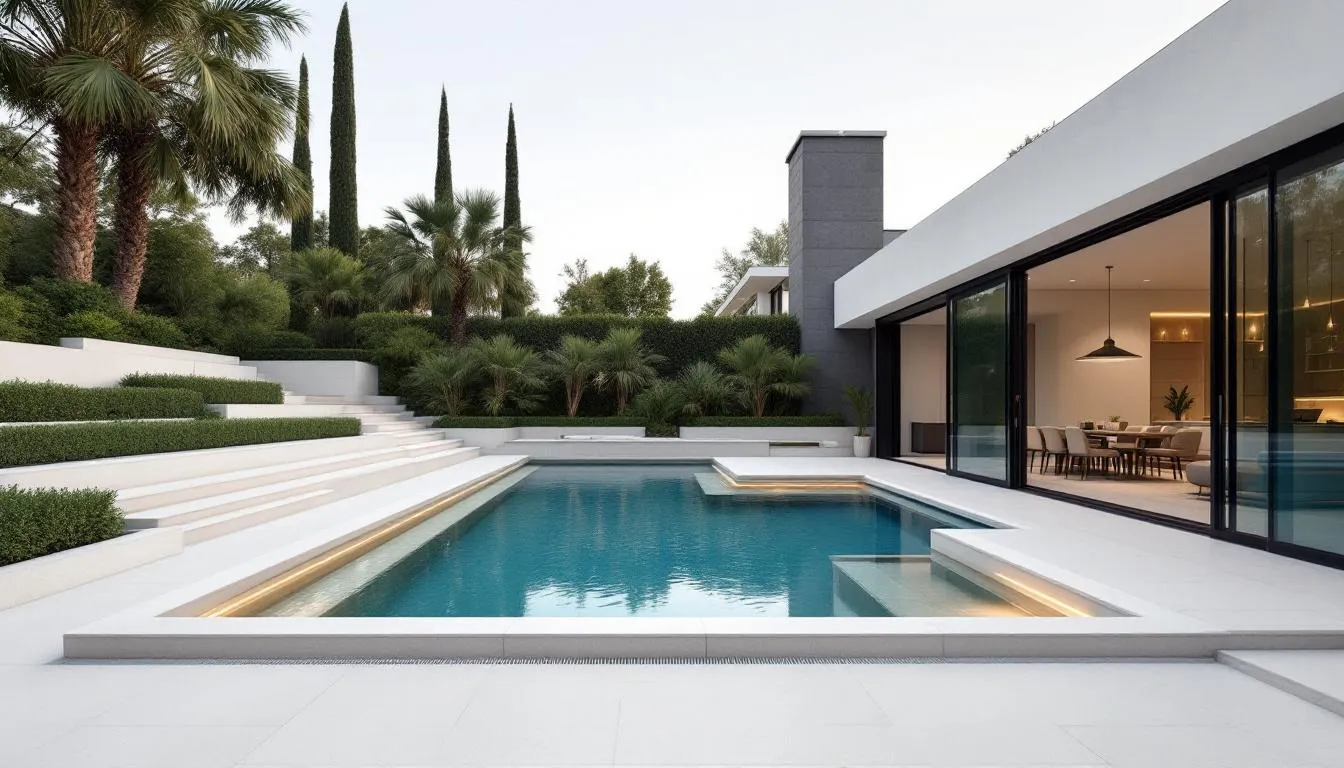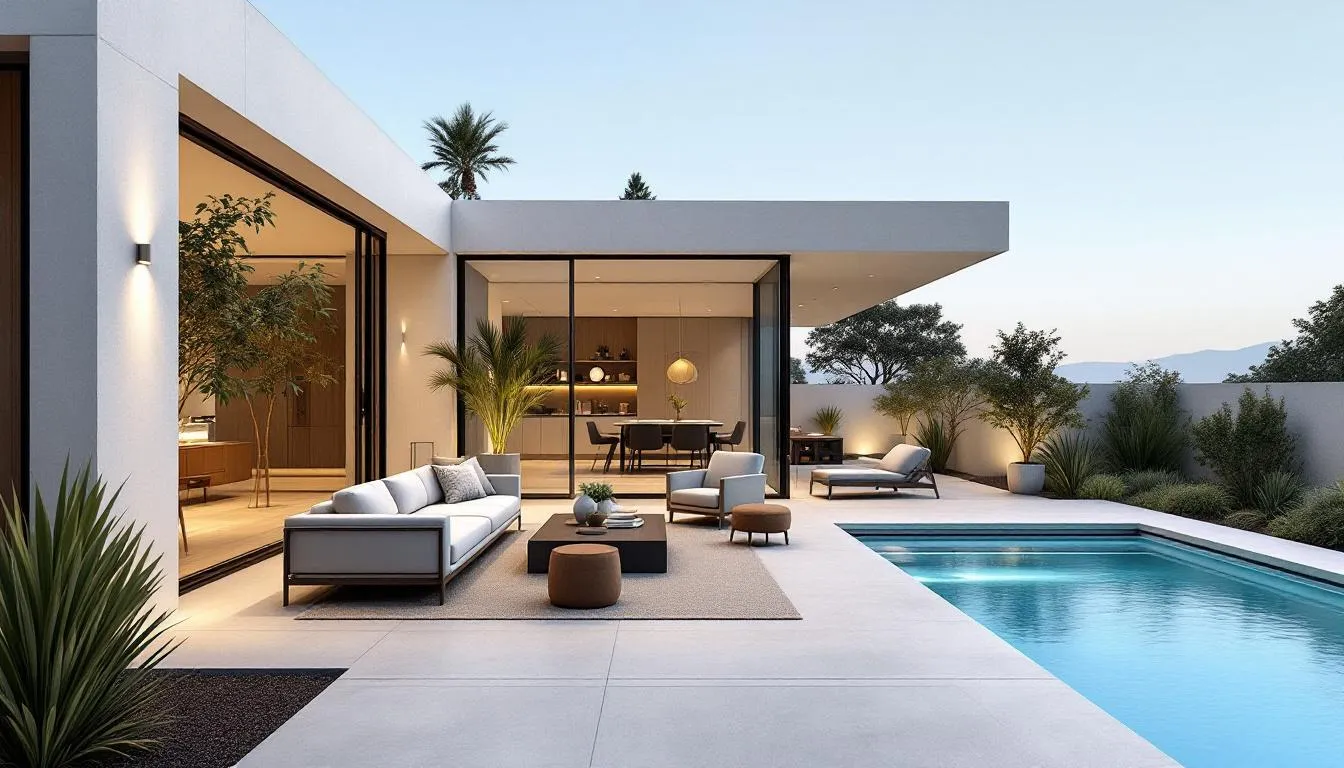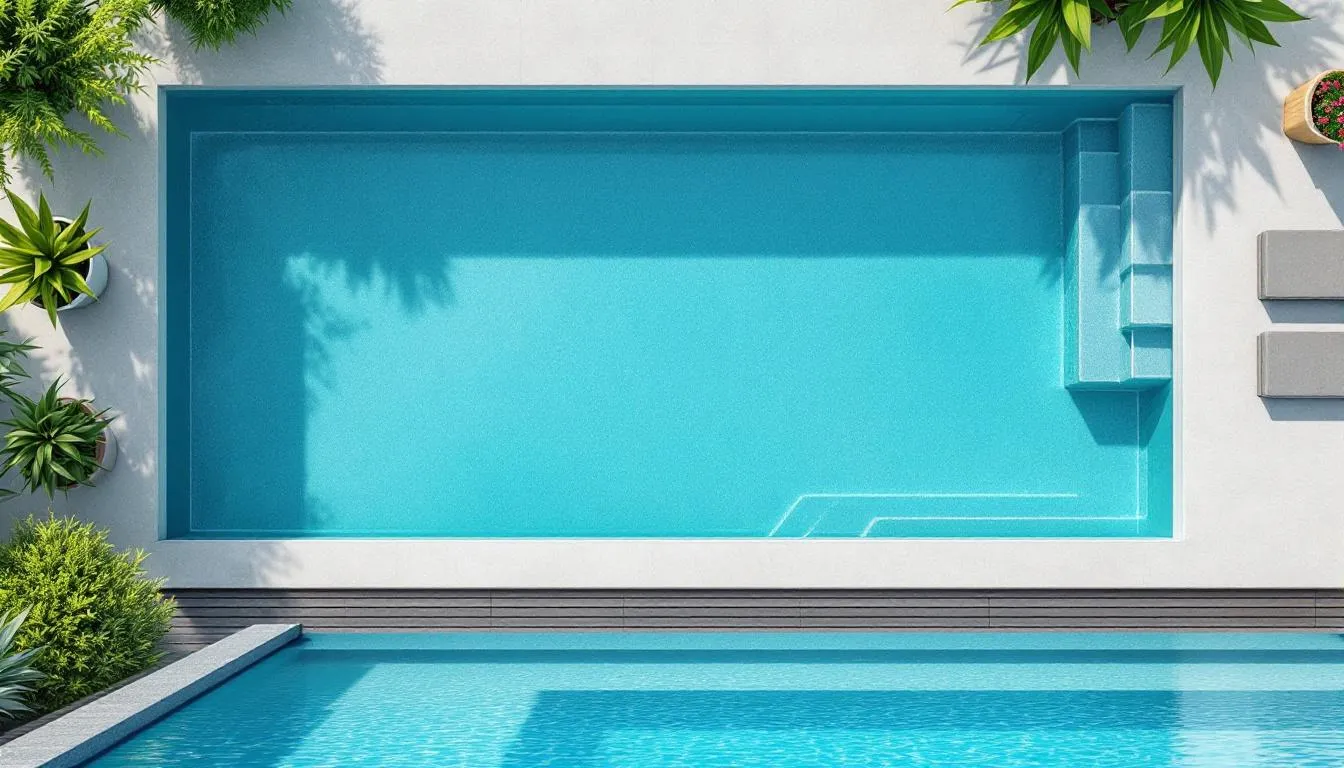
The Ultimate Guide to Landscape Design and Installation for Residential Swimming Pools: Transform Your Backyard Oasis
Key Takeaways
Meticulous planning, including setting clear goals and understanding local building codes, is essential for a successful backyard pool project.
Choosing the right type of pool and conducting a thorough site analysis are crucial steps in ensuring the aesthetics and functionality of the landscape.
Regular maintenance and collaborating with professionals, such as landscape designers and pool contractors, enhance the longevity and quality of your pool oasis.
Planning Your Backyard Oasis

Creating the backyard of your dreams starts with meticulous planning. Your new swimming pool and its surrounding landscape should reflect your personal preferences, fit within your space constraints, and align with your budget. Meticulous planning helps create a unique and welcoming backyard oasis for lasting enjoyment.
This section will guide you through the initial steps of setting goals for your pool project, understanding local building codes, and choosing the right pool type. These elements lay the foundation for a successful project, transforming your backyard into an inviting environment.
Setting Goals for Your Pool Project
Setting clear objectives for your swimming pool and outdoor spaces guides your design process. Start by envisioning your dream pool and considering how you plan to use it—whether it’s for exercise, relaxation, or family entertainment. A clear budget guides the scope of your pool project and helps manage expenses effectively.
The size of your yard will significantly shape your landscape design, presenting unique challenges and opportunities. With a clear vision and budget, review the final plan, including design, materials, and budget considerations, before construction begins. This thorough approach ensures every aspect of your pool project aligns with your goals and expectations.
Understanding Local Building Codes
Knowledge of local building codes ensures your pool is built safely and meets all legal standards. Compliance with these regulations helps avoid potential legal issues and ensures the durability and functionality of your inground pool.
Non-compliance can lead to fines and possible removal of the pool.
Choosing the Right Pool Type
Selecting the right type of swimming pool impacts the overall aesthetic and functionality of your backyard oasis. There are three main pool types of inground pools. They are concrete, vinyl, and fiberglass.
Fiberglass pools, constructed using a pre-made fiberglass shell, offer affordability, durability, and low maintenance requirements. Concrete pools, known for durability and extensive customization, come at a higher cost but offer unparalleled design flexibility.
Vinyl pools are less expensive and provide good insulation but require periodic replacement and more maintenance than fiberglass pools. Evaluating each pool type based on durability, customization, and maintenance needs will help you choose the perfect pool for your outdoor space.
Site Analysis and Preparation

A thorough site analysis helps identify the best location for the pool and potential challenges before construction begins. Effective landscape design involves selecting plants and materials based on the environment and conducting a comprehensive site survey to guide the pool’s placement and design.
This section will cover assessing the existing landscape, preparing the ground for excavation, and managing water drainage. These steps lay a solid foundation for your pool, ensuring the longevity and functionality of your pool landscape.
Assessing the Existing Landscape
Consider factors such as local building codes, topography, soil composition, and elevation changes when assessing the available space for a pool. Analyzing sun and shade patterns, landscaping, and layout elements helps effectively assess the area for a pool.
Familiarity with landscape design principles enables you to make informed decisions that harmonize with the natural environment. Assessing the existing landscape identifies opportunities and constraints that will inform your pool design, landscaping elements, and landscape construction.
Preparing the Ground for Excavation
Site preparation includes marking utility locations and obtaining necessary permits before excavation. Excavation requires digging a space that exceeds the pool dimensions by about 8 to 12 inches to ensure a snug fit for the pool shell.
The installation of plumbing and electrical systems is essential for the functionality of pool pumps and filters. Matching the design specifications during excavation ensures the shape and depth are accurate.
Managing Water Drainage
Effective drainage solutions redirect surface runoff and protect the pool’s structural integrity. Consider factors like soil composition and drainage patterns during site assessment to ensure proper water management.
A well-planned drainage system mitigates water pooling around the pool area, preventing structural issues and long-term damage.
Designing Your Perfect Poolscape

Designing your perfect poolscape combines art and science. It involves arranging outdoor spaces to achieve balance and functionality, while selecting the right plants, hardscape materials, and lighting to transform a pool area.
This section will explore incorporating hardscaping elements, selecting plant species, and creating focal points. Integrating these aspects into your poolscape design creates a unified outdoor environment tailored to your preferences.
Incorporating Hardscaping Elements
Hardscape features provide structure and define spaces in landscape design, illustrating how different elements like benches, outdoor fireplaces, concrete pavers, and natural stone walkways can add both style and practicality to your pool area.
Selecting suitable hardscaping materials like natural stone or composite decking significantly improves both the look and utility of the pool area. Proper installation ensures the durability and functionality of these paving materials.
Selecting Plant Species
Greenery around the pool area softens its appearance and enhances its connection with the natural environment. Tropical plants like palm trees, hibiscus, and banana plants can elevate the ambiance around a pool.
Native plants can significantly reduce water usage for irrigation.
Creating Focal Points
Focal points in your landscape enhance visual appeal and draw attention to key areas. Designating areas for flower beds, palm trees, and garden beds creates inviting focal points, improving both aesthetics and the overall experience of your outdoor space.
Installing the Swimming Pool
Installing your swimming pool requires precision and expertise. The installation process involves site preparation, grading, and leveling to ensure the stability and longevity of an inground pool.
This section will cover the steps involved in excavation, setting up pool equipment, and filling and testing the pool as part of the construction process. Each step ensures the durability and functionality of your new swimming pool.
Excavation and Pool Shell Installation
The types of soil on your property impact excavation and pool stability. Analyzing access points for construction equipment ensures efficient movement during installation.
Pools can ‘pop’ out of the ground if groundwater pressure is not controlled. The pool shell is set into the excavation with precision to maintain an even surface and prevent future issues. Groundwater pressure on the pool shell can cause shifts or cracks in the structure.
Setting Up Pool Equipment
A dedicated equipment pad houses the pool’s pump, filter, and other mechanical components. The equipment pad should allow easy access to components like the pump, filter, and heater, essential for maintaining water quality.
Understanding the pool components, such as the filter system and skimmers, is crucial for effective maintenance.
Filling and Testing the Pool
Fill the pool gradually to prevent structural damage and ensure proper settling. After filling, ensure all installed equipment, like pumps and filters, are functioning correctly to maintain water clarity and sanitation.
A professional pool contractor ensures correct installation and adherence to safety standards, minimizing costly repairs.
Enhancing Your Pool Area

Enhancing your pool area can transform a simple swimming pool into a luxurious backyard oasis. Features that enhance its functionality include:
An outdoor kitchen
Bar area
Bathroom
Living room
Storage space
This section will explore adding water features, designing an outdoor living room, and implementing pool safety features. These enhancements elevate the aesthetic appeal and functionality of your outdoor living spaces.
Adding Water Features
Water features like waterfalls and fountains elevate the aesthetic appeal and create a soothing atmosphere around pools. Built-in water features can include:
Sculptures
Fountains
Waterfalls
Bubbling rock beds
Cascading waterfalls serve as captivating focal points, enhancing both relaxation and ambiance.
Waterfalls, streams, and fountains enhance the tranquility of a pool area with various pool features.
Designing an Outdoor Living Room
A canopy or shade structure provides necessary shade in a pool area. Structures like pergolas, gazebos, and cabanas offer both privacy and shade for your outdoor living space.
Outdoor kitchens or bars with essential appliances elevate poolside entertainment and dining experiences, including hot tubs.
Implementing Pool Safety Features
Ensuring pool safety is paramount to creating a safe environment for everyone. Non-slip surfaces, adequate fencing, and automatic pool covers significantly enhance safety around the pool area.
Self-closing gates with child-proof latches provide additional security, especially for families with young children. Alarms or security cameras improve monitoring and help prevent accidents.
Ongoing Maintenance and Care

Regular upkeep is essential to maintain the beauty and functionality of your swimming pool and surrounding landscape. Consistent maintenance routines keep the pool and landscaping elements appealing and functional year-round.
This section will cover regular pool maintenance, landscaping upkeep, and seasonal adjustments. Integrating these maintenance routines prevents costly repairs and ensures a beautiful and functional backyard oasis year-round.
Regular Pool Maintenance
Balancing chemical levels in your pool water ensures a safe and enjoyable swimming environment. Maintaining the correct water level is vital for the efficient operation of the pool’s filtration system. Before using the pool, fill it with water, check all systems, and ensure chemical levels are balanced.
Regular maintenance can help prevent costly repairs and extends the life of your pool with less maintenance.
Landscaping Upkeep
Regular pruning and managing irrigation keeps the landscape aesthetically pleasing and healthy. Pruning prevents overgrowth and maintains a neat appearance in landscaped areas around the pool. It also reduces debris in the water, contributing to the overall cleanliness and functionality of your pool landscape.
Seasonal Adjustments
Adapting maintenance routines to seasonal changes protects your pool and landscaping from weather damage. Adjusting landscaping and pool care routines for each season prevents damage from extreme weather.
Tailoring maintenance practices to the local climate and personal preferences ensures your backyard oasis remains in top condition year-round.
Collaborating with Professionals
Collaborating with professionals significantly contributes to achieving your dream pool and landscape. Landscape designers blend creativity with practicality to design a fitting landscape for your pool area. Professional installation ensures your pool provides decades of enjoyment through proper setup and maintenance.
This section will cover the benefits of hiring a landscape designer, choosing a pool contractor, and working together for the best results. Engaging professionals ensures every aspect of your landscape project is handled with expertise and precision.
Hiring a Landscape Designer
A professional landscape designer creates a cohesive and custom landscape plan tailored to your needs. A professional designer brings knowledge of design principles, horticulture, and construction techniques. Comprehensive planning in pool landscape design involves site analysis, plant selection, material sourcing, budget management, and collaboration with landscape architects.
Before selecting a landscape designer, research extensively and ask about their experience and qualifications. A well-chosen designer can transform your backyard into a functional outdoor space that reflects your personal style and preferences.
Choosing a Pool Contractor
Choosing a reputable pool contractor is essential to ensure the proper construction and installation of your swimming pool. A professional pool contractor can help ensure compliance with local building codes for pool construction.
Pool installation firms primarily construct pools according to specifications but do not handle design aspects. Therefore, selecting a contractor with a strong track record in the pool installation process is crucial for a successful project.
Working Together for Best Results
Collaboration between landscape designers and pool contractors is crucial for achieving a cohesive and aesthetically pleasing outdoor space. A clear understanding between both parties ensures that the entire process runs smoothly, resulting in a successful project.
By working together, you can create a harmonious backyard oasis that meets your vision and exceeds your expectations.
Summary
Creating the perfect backyard oasis involves meticulous planning, thorough site analysis, and expert execution. Setting clear goals for your pool project, understanding local building codes, and choosing the right pool type are foundational steps. Proper site preparation, including assessing the existing landscape, preparing the ground for excavation, and managing water drainage, ensures the stability and longevity of your pool.
Designing your perfect poolscape with hardscaping elements, plant species, and focal points adds both beauty and functionality to your outdoor space. Enhancing your pool area with water features, an outdoor living room, and safety features creates an inviting environment. Ongoing maintenance and collaboration with professionals ensure that your backyard oasis remains stunning and functional for years to come.
Frequently Asked Questions
What are the primary types of inground pools?
The primary types of inground pools are concrete, vinyl, and fiberglass, each offering distinct benefits and drawbacks in terms of durability, customization, and maintenance. Choosing the right type depends on your specific needs and preferences.
Why is it important to understand local building codes before starting pool construction?
It is essential to understand local building codes before starting pool construction to ensure safety and compliance with legal standards, as failing to do so can lead to fines and the potential removal of the pool.
How can I enhance the visual appeal of my pool area?
To enhance the visual appeal of your pool area, consider adding hardscaping elements such as benches and outdoor fireplaces, while integrating natural stone walkways and greenery to create a stylish and inviting environment. This strategic combination will elevate the overall aesthetic of your space.
What are some safety features I should consider for my new swimming pool?
When considering safety features for your new swimming pool, prioritize non-slip surfaces, secure fencing, automatic pool covers, self-closing gates with child-proof latches, and monitoring systems like alarms or security cameras. These measures significantly enhance safety for all users.
How often should I perform maintenance on my pool and surrounding landscape?
You should perform regular maintenance on your pool and landscaping, including balancing chemical levels and pruning plants, adapting your routines to seasonal changes to ensure everything remains in top condition. Consistency is key for optimal upkeep.

